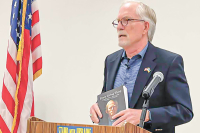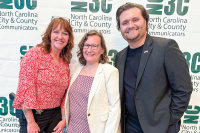An artist for life
By Michael Beadle
Painter Susan Lanier remembers how she used to get in trouble as a young artist.
In first grade, she was drawing a princess for her cousin, who could only do stick figures. The teacher grabbed the paper out of Lanier’s hand and instructed her in no uncertain terms that students are to do their own work.
But Lanier couldn’t resist. She had an early love for drawing. Her mother, an arts coordinator in Forsyth County before Susan was born, would do portraits of her children after marrying and settling down in Waynesville.
As a16-year-old, Lanier and her family when out West one summer, touring all the big national parks. When she got back, she completed her first original painting of a Big Sur California scene.
Art has been a lifelong love ever since.
Lanier recently showcased her paintings at Gallery One in Sylva and had a successful one-woman show at the WNC Visitors Center in Waynesville last November.
“My house is my gallery,” Lanier jokes, offering a tour of her work.
She often paints on the back porch of her stone house in Cullowhee, the one her grandparents once lived in, off N.C. 107 beyond the bustle of Sylva, beside the cool rushing waters of the Tuckasegee River.
A former art teacher who spent eight years with Haywood County Schools, Lanier left the profession in 1991 and took a hiatus, working odd jobs before getting involved with the Jackson County Visual Arts Association. Inspired by friendships with artists in Cherokee, she jump-started her own creative talents.
“The arts in Cherokee are huge,” Lanier said. “That’s been a good outlet for me and my talents.”
When Harrah’s Casino in Cherokee was being built, she was hired to work with Cherokee students and local woodworker James Smith who had been commissioned to do a painting. The project took four months of after-school and weekend work and is now on display in a side room off the casino’s main lobby.
Lanier now works full-time as the program coordinator for Southwestern Community College’s Gear-Up program, which helps students in grades six through nine gain early awareness about college. She sets up after-school tutoring, cultural arts activities, and college awareness programs with a bent on math and science.
One year, as a home economics teacher at Cherokee High School, she and her students decided to create their own restaurant, working on everything from designing and making curtains, napkins and placemats to putting together a cookbook and menus to cooking and
serving the food and managing the day-to-day operations. It was called the Turtle Island Cafe. Students designed their own logo using the Cherokee syllabary and ran their own restaurant for two months.
“It was a tremendous learning experience,” Lanier said.
Her art reflects a deep respect for Cherokee culture. In one of her paintings called “Dancing Feet.” she found inspiration from a photograph of a pow-wow at Cherokee High School. The view of the dancers is from the legs down, with limbs dressed in jingles and bright colors. Pairs of feet lift off the ground as if floating.
Unlike some artists who sketch or paint a series of pieces, Lanier mulls over her subject before turning to the canvas.
“I dream about them before I paint them,” Lanier says.
Because the moment of art conception is always different, no two paintings are ever the same. For her, everything comes from its own unique emotional space. It’s hard to know when a piece is finished, she says, but you intuitively learn to recognize when to stop, when to pause, when to continue.
“And that’s something that develops as you mature as an artist,” she says.
In one of her most intricate works, “Cherokee Baskets,” an acrylic painting, she mixes a realistic image of two hand-crafted Cherokee baskets with an abstract background of pastel panels that shoot out like leaves. It’s as though the baskets give off an aura of magic. Lanier carefully captures both the complex woven pattern and the slight bulge of the basket’s sides.
As a child, Lanier recalled seeing Cherokee women come by her grandmother’s house — now the renovated home she and her husband live in —to harvest rivercane for baskets.
When Lanier recently went with Cherokee students to visit the Heard Museum, a Native American art collection in Phoenix, Ariz., all the baskets that the students brought were sold — a testimonial to the enduring quality of Cherokee handmade baskets.
In Lanier’s painting “Night Dive,” brilliant hues of purples, blues and greens turn tropical fish into an undersea wonder. In “Painted Ponies” two heads of horses gallop in a dreamscape as a face with closed eyes watches over them like a protective spirit — or perhaps it’s the other way around. The fractured light and texture give us a glimpse of longing memory and the blissful surrender to adventure.
Lanier likes to place ancient symbols in a modern context. In “Judaculla and His Wife,” for example, modern art takes on an ancient legend. Judaculla, a mythical Cherokee giant, and his wife are given cave art profiles with Kokopeli-style hair. The abstract background of interwoven vertical and horizontal brush strokes in reds, browns and yellows could have the couple time-traveling through space.
Lanier and her family have done plenty of traveling — New Zealand, Costa Rica, Italy, Mexico, Hawaii and Southwestern United States. In Florence, Italy, she got to see all those paintings she’d studied in art history. On Christmas vacations, the whole family would go off to somewhere.
Lanier not only sought out artwork in these various places whether it was the architecture or the sculptures or a Monet exhibit of Impressionism. She’d bring back those insights and experiences to pass along to her students.
Lanier worries that too often school budgets tend to skimp on art classes, which get compartmentalized and separated from the “regular” academic subjects, and the high stakes testing policies of No Child Left Behind leave little room for innovative teaching.
“And that has restricted a lot of the teachers’ creativity,” Lanier said.
But as an art educator, she likes to remind students and others that art is not a simple multiple-choice test or a subject only left for the talented few. Art is about challenging minds to think for themselves. Artists have to work not only on the techniques of their art form. They must also learn to develop self-reflection, evaluation, critical thinking and problem-solving skills — from choosing the right colors to planning out a piece to overcoming obstacles like fitting images into a particular space. Everything within art is about problem solving, Lanier says. Instead of thinking outside the box, as the old saying goes, she likes to call it “opening the box” to new possibilities.
“I like to see kids stop and have to think,” she says. “Art is something that becomes a part of you and who you are.”
It also connects you to the different cultures of the world, she adds. And what better way to prepare students for college and the future than to give them art skills.
For Lanier, art is not merely what she teaches or practices on a canvas. It’s something she lives daily. It’s a creative mindset, whether she’s cooking a dish or gardening, she’s mixing colors, trying out new designs, finding a new perspective.
“Everything’s art to me,” she says. “It enriches my life.”
For more information about Lanier’s work, go to the Web site www.wncartists.com/painting/susan_lanier/.





